March 21, 2023
|
Nathan Wheadon
How To Reduce Your Fleet Fuel Expenses
Increasing your on-site productivity and efficiency can lead to a big boost in revenue. The more jobs you can complete, the more money you can make. But what about all of the expenses you incur between jobs? What is your true cost-per mile? How much are fleet expenses eating into your profit margins?
In this post, we’re focusing on your operational expenses ‘in-between’ jobs – specifically how the seasonal fluctuation in fuel prices can impact your business.
Retail gas prices are always highest between March – September. Prepare to pay more at the pump through the spring and summer months. For businesses that rely on fleet vehicles, the spike in fuel prices can have a major impact on profit margins.
Your fleet can be more fuel efficient. The less fuel you burn, the more money you’ll save. We’ll dive into a few ways you can save BIG by being smarter with your fleet fuel consumption and how you can use Momentum to mitigate the impact of seasonal fuel price increases.
Let’s start with idling.

Monitor Your Fleet Idling. Save Money.
An average light-or-medium duty truck can burn anywhere from a 1/2 gallon to more than a full gallon of gas in just one hour of idling! There’s ~260 working days in a year (excluding holidays + weekends) and the current national average price per gallon of gas is $3.87. Based on that amount, just one hour of daily idling could cost you $1,000 PER VEHICLE every year. If you operate in states with high fuel prices, like California, Hawaii, Nevada, Washington, Oregon or Arizona, the financial impact is even greater.
If you don’t control your fleet idling, you’re overspending on fuel, and with historically high fuel prices, inefficient fuel usage can really affect your bottom line.
That’s why it’s so important to manage, monitor and control your fleet idling. A great place to start is by creating an idling monitor in your Momentum account. Not using Momentum? Try it FREE for 30 days.
Check out the video below to see how one Momentum user saved $10,000 in fuel expenses!
Create Your Excessive Idling Monitor Today
Excessive Idling is one of the most popular Momentum monitors. It allows you to track idling trends and receive real-time alerts when your vehicles are idling for too long. Use this guide to set-up your Excessive Idling monitor, or view below.
Here’s how the excessive idling monitor works:
1) Choose Your Monitor
Select the “Excessive Idling” monitor from the menu.
Tip: check back on the Momentum blog for more insights into other Momentum Monitors! Our Monitors will help keep you in the know with important operational/business KPIs

2) Name Your Monitor
Tip: this could be the name of the vehicle, the driver of the vehicle, the location of the vehicle or some other naming convention that makes sense for your operations.

3) Set an Idling Limit
Use the preset 15 minutes, or customize an idling time based on your unique business factors, like vehicle usage or the climate you operate in.
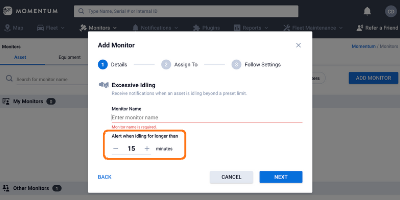
4) Assign the Monitor to:
Your entire fleet (global)
Ideal for small fleets (10 vehicles or less) that should all be following the same standards. Set a single, standard idling limit that applies to all of your fleet vehicles.

By Location
Some businesses operate in multiple geographic locations across the U.S. and Canada, and based on weather and climate, their idling limits should vary. If you operate in extreme cold or heat, your fleet vehicles will have longer idling times compared to those who operate in more temperate climates.
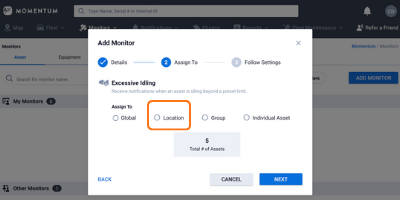
By Group
Groups can be segmented by vehicle types or classifications, departments, divisions, branches, seniority level or any other cohort based on the structure of your business, operations or accounting rules.

By Individual Asset
You can monitor and track based on an individual vehicle or employee (if the same employee always drives the same fleet vehicle, for example).
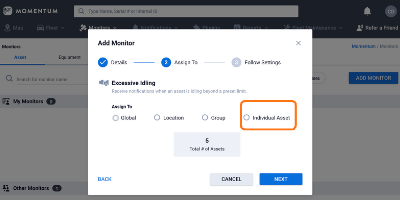
That’s it! Setting up an idling monitor is easy – it’ll only take a minute! But if you need som help, check out these helpful step-by-step guides OR schedule a chat. Someone from our crew will give you a call at your convenience!
Real-Time Alerts and Reporting
You can get alerted by email, text or an in-app notification any time a vehicle exceeds your idling limits and you can see idling trends over time with idling reports.
Did you improve from one month to the other? What impact is seasonal fluctuation in temperature having on your overall idling levels? How is that effecting your fuel expenses and your average cost-per-mile?
Fuel idling reports will give you a clear understanding of your current idling performance, and will allow you to easily identify where and how you can improve.
Filter your report by time periods, individual assets, groups and locations. Reports make it easy to see the real effect idling is having on the financial viability your business. When you remove the guesswork from your operations, you’ll have a big advantage over your competitors.
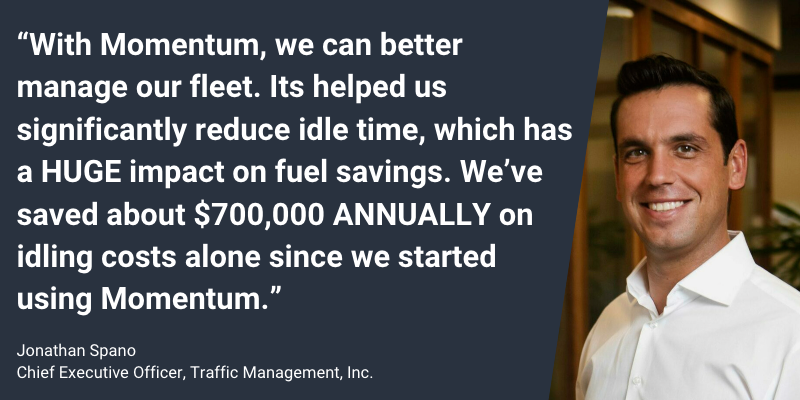
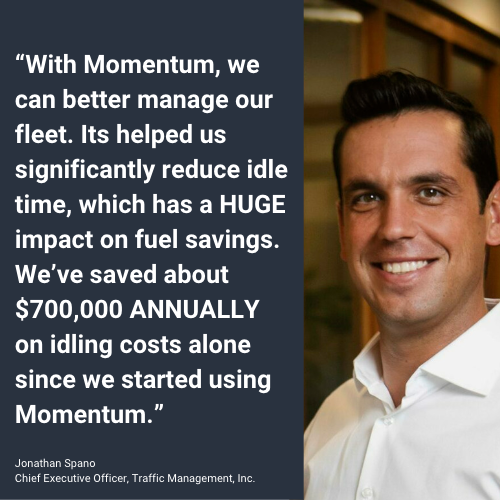
Control Your Vehicle Speed. It’s Safer AND More Fuel Efficient.
Speeding is a major safety issue for any field service business. According to the National Highway Traffic Safety Association, 308,013 people injured as a result of speeding in 2020 (the last year the NHSTA has provided data).
Speeding is dangerous. It’s costly. And it’s avoidable. Driving too fast is costly in terms of risk and potential damages to your business, but speeding also hurts your fuel efficiency.
Driving fast can be really inefficient.
According U.S. Department of Energy: “while vehicles reach optimal fuel economy at different speeds, gas mileage usually decreases rapidly at speeds above 50 miles per hour (mph). For light-duty vehicles, for example, every 5 mph you drive over 50 mph is like paying $0.18 more per gallon of gas (based on the price of gas at $2.63 per gallon). Reducing your speed by 5 to 10 mph can improve fuel economy by 7%–14%.”
Whatever you think you’re gaining in time saved, you’re probably losing in the amount of fuel you’re burning.
Here’s what you need to think of if/when you’re trying to make up time on the road by speeding: in reality, speeding doesn’t really save you THAT much time. Just look at this chart:
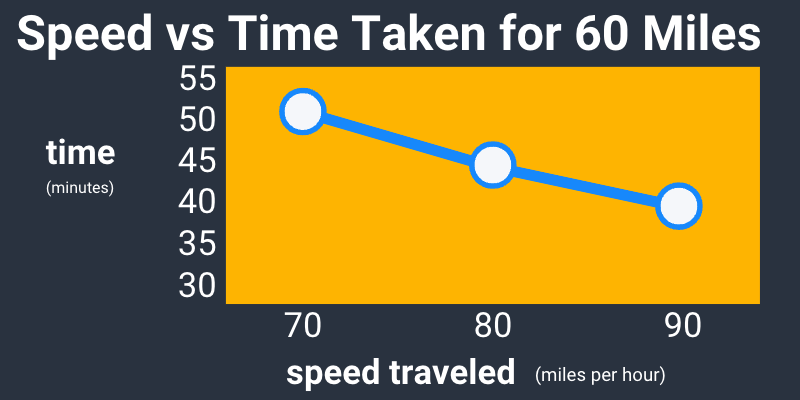
If you’re driving a distance of 60 miles at 70 mph, you’ll arrive at your destination in 51.4 minutes; at 80 mph it’ll take 45 minutes; and at 90 mph, it’ll take 40 minutes. The risk/reward of speeding vs time-saved is minimal. And for shorter distances, the time saved is even less! Here’s a cool breakdown of speeding vs time saved.
Practicing good driving habits, monitoring your speed and traveling at appropriate speeds is good for safety AND your bottom line.
See Vehicle Speed In Real-Time With Momentum
When a vehicle is moving, you can use the map in the Momentum app to see it’s travel speed in real-time. All routes and trips are color-coded based on the speed of the traveling vehicle. It’s really easy to see how fast your vehicles are traveling, and also, where unsafe behavior (like speeding) occurs. For example, are your fleet vehicles traveling too fast on the highways? You’ll be able to see at a glance.

Get Alerts When Vehicles Are Speeding With Momentum
But if you’re not glued to the Momentum app to check fleet activity in real-time, you can create Speeding monitors and alerts. Get alerted by email, text or an in-app notification any time a vehicle exceeds a pre-set speed. To create Speeding alerts, follow the same process as detailed above or for additional direction, view our helpful guides here.
Login To Your Momentum Account or Sign Up Today
Login to your Momentum account to create Monitors and Alerts for Excessive Idling and Speeding. Or, Sign Up for Momentum today. We’ll even let you try it free for 30 days!
Questions about Monitors, Alerts, Reports – or anything else related to Momentum? Give us a call at 323-831-3475 or schedule a time for one of our team members to call you back!
